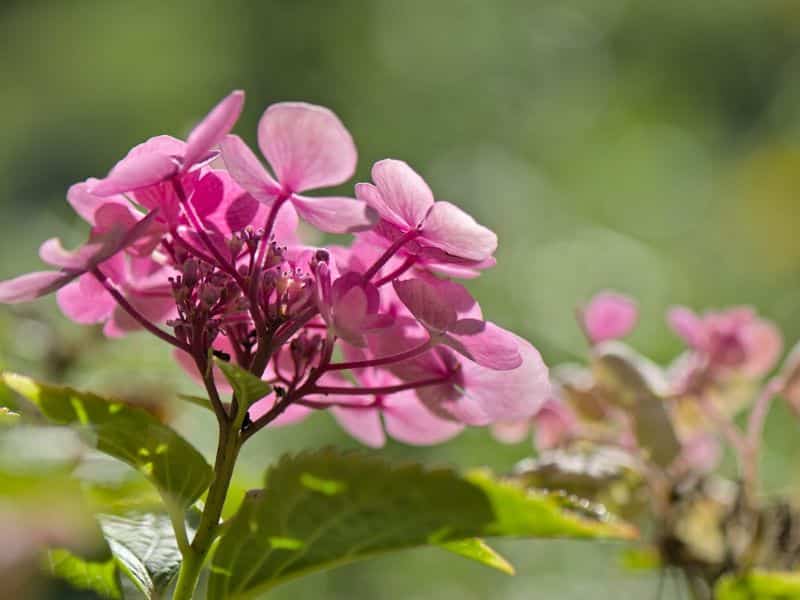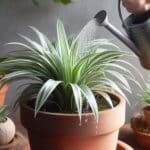Discovering your hydrangea’s leaves turning yellow can be disheartening, especially when you’ve invested time and effort into nurturing your garden. This common issue, however, is more than just a cosmetic concern; it’s a cry for help from your plants, signaling that they need your attention.
Whether it’s due to nutritional deficiencies, improper watering, or pest attacks, understanding the root cause is crucial for restoring your hydrangea’s health and vibrancy.
Fortunately, you’re not alone in this journey. With the right knowledge and a bit of care, you can pinpoint the issue and take effective steps to remedy it.
This article will guide you through the possible reasons behind the yellowing leaves and offer practical solutions to get your hydrangeas back to their lush, flourishing state. Let’s dive in and turn those yellowing leaves into a problem of the past.
Understanding Hydrangea Leaf Yellowing
The Basics of Hydrangea Plant Care
Taking care of hydrangeas starts with mastering a few key elements: sunlight, watering, and soil quality. Hydrangeas thrive in environments that receive morning sun and afternoon shade.
Overexposure to direct sunlight can stress them, leading to yellow leaves. Water requirements vary by location, but as a rule of thumb, keep the soil moist, not drenched. The soil should be rich, well-draining, and slightly acidic.
Checking these parameters regularly ensures your hydrangeas remain vibrant and healthy. This is more than just routine; it’s about creating the ideal conditions for growth and flourishing.
Identifying Yellow Leaves in Hydrangeas
Seeing yellow leaves on your hydrangeas can be concerning, but identifying the cause is your first step towards remedy. Yellow leaves often result from water stress, either too much or too little.
But, don’t overlook other causes like nutrient deficiencies or pests. Iron deficiency, for example, can turn leaves yellow while keeping veins green. Similarly, a pest infestation may well not only discolor leaves but also leave other signs of damage.
Assess your plants thoroughly, examining the pattern and extent of yellowing. This observation helps pinpoint the issue, leading to a more effective solution.
Common Causes of Hydrangea Leaves Turning Yellow

Watering Issues: Overwatering and Underwatering
Understanding the balance in watering your hydrangea is critical. Overwatering a hydrangea leads to root rot, a condition where roots can’t uptake nutrients or water efficiently, causing leaves to turn yellow.
Conversely, underwatering deprives your plant of moisture, leading to stressed-out, yellow leaves. The trick is ensuring the soil is moist but not soggy, like that perfect sponge cake consistency.
Soil Conditions and Nutrient Deficiencies
Soil quality plays a huge role in the health of your hydrangea. If the soil drains too quickly or is too clayey, it won’t hold the right amount of moisture your plant craves. Nutrient deficiencies, particularly iron, can cause leaves to turn yellow while veins remain green, a condition known as chlorosis.
Applying a soil amendment or fertilizer designed for hydrangeas can correct these deficiencies, bringing your plant back to its vibrant self.
Environmental Stressors and Plant Diseases
Your hydrangea may well act like a diva sometimes, showing signs of stress when the environment isn’t just right. Too much sun can scorch its leaves, turning them yellow, while too little leaves them craving those sunny rays.
Certain diseases like leaf spot or powdery mildew also contribute to yellowing if not addressed promptly. Ensuring your hydrangea has the perfect spot with just the right amount of sunlight and is monitored for diseases will keep your plant happy and healthy.
Troubleshooting Yellow Leaves on Hydrangeas
Reviving your hydrangeas and restoring their vibrant green foliage involves a few critical steps, especially when you notice yellow leaves. Here’s how to tackle the issue effectively:
Assessing Your Watering Routine
Overwatering and underwatering are prime suspects in the case of yellowing hydrangea leaves. Your plants thrive on balance, so it’s crucial to find the right watering rhythm. Hydrangeas generally prefer moist, well-drained soil.
If the soil feels soggy or bone dry, it’s time to adjust your approach. Aim for consistent moisture, especially during hot, dry spells, but don’t overdo it. Letting the soil dry slightly between waterings can help prevent root rot, which often leads to yellow leaves.
Checking Soil pH and Nutrient Levels
Hydrangeas are quite picky about their soil conditions, with a preference for slightly acidic to neutral pH levels. If your soil is too alkaline, your hydrangeas may well struggle to absorb iron, leading to chlorosis, a condition characterized by yellow leaves with green veins.
A simple soil test can reveal your garden’s pH level and nutrient profile. Amending your soil with sulfur to lower the pH or adding iron supplements can counteract chlorosis. Remember, a balanced diet of nutrients is key to lush, green leaves.
Inspecting for Pests and Diseases
Last but not least, pests and diseases can turn hydrangea leaves yellow, signaling distress. Common culprits include aphids, mites, and fungal diseases like leaf spot. Take a close look at your plants. Spotting bugs or unusual patterns on the leaves often points to the problem.
Gentle, regular washes with water can deter pests, while fungicides address fungal issues. However, prevention is your best ally. Ensuring good air circulation around your plants and avoiding wet leaves can keep pests and diseases at bay.
Preventative Measures for Healthy Hydrangeas
Proper Watering Practices
Hydrangeas thrive when they’re neither parched nor drowning. To hit that sweet spot, aim for about 1 inch of water per week, more if the weather’s hotter than usual. A slow, deep watering method helps the roots absorb moisture effectively.
This approach simulates a good soaking rain, encouraging deeper root growth and stability. Remember, overenthusiasm with the hose or watering can leads to sogginess, setting the stage for root rot and yellowing leaves.
Ideal Soil Preparation and Fertilization
The foundation of vibrant hydrangeas starts underground. For these plants, slightly acidic to neutral soil (pH 6 to 7) is where they’re happiest. Testing your soil’s pH can save you from future frowns if your hydrangeas start looking sickly.
Adjusting your soil with sulfur or lime, depending on the result, ensures your plants can access the nutrients they need. A balanced 10-10-10 fertilizer applied in the spring gives them that extra kick to grow strong and colorful.
Adequate Sunlight and Weather Protection
Sunlight and hydrangeas have a love-hate relationship. They enjoy basking in the morning light but prefer to avoid the harsh afternoon rays. A spot that offers morning sunlight and afternoon shade is your garden’s sweet spot for these beauties.
In areas with unpredictable weather, consider protective measures like shade cloth or planting in a location that naturally offers afternoon protection. By balancing their love for the sun with a bit of shade, you’ll prevent those lush leaves from turning a sorrowful yellow.
Corrective Actions to Revive Yellowing Hydrangeas
The health of your hydrangeas hinges on a few key practices, especially if their leaves have started to turn yellow. Following a precise strategy to counteract this issue involves several steps that can lead to the rejuvenation of your plants. This section delves into actionable measures you can take to breathe life back into your hydrangeas.
Adjusting Watering Habits
Over or under-watering can lead to yellow leaves, signaling that your hydrangeas aren’t happy with their current hydration situation. Check the soil moisture by feeling it — it should be moist but not soggy.
Aim to water your plants deeply yet infrequently, allowing the top inch of the soil to dry out before watering again. This method encourages stronger root growth and reduces the risk of root rot, which is a common cause of yellowing leaves.
Soil Amendments and Fertilizer Application
Soil health is paramount for healthy hydrangeas. If your soil is too alkaline or acidic, it can hinder nutrient absorption, leading to yellow leaves. Conduct a soil pH test; for most hydrangeas, a pH of 6 to 7 is ideal. Adjusting your soil pH with amendments such as sulfur to lower the pH or garden lime to raise it can make a significant difference.
Additionally, a balanced, slow-release fertilizer applied in early spring can supply your hydrangeas with the necessary nutrients for vibrant foliage and blooms. Remember, less is more with Hydrangea fertilizer — overuse can harm your plants more than help.
Treating Pests and Diseases
Pests and diseases can wreak havoc on hydrangea leaves, turning them yellow as a cry for help. Inspect your plants regularly for early signs of infestation or illness, such as discolored spots or holes in the leaves. If you discover any pests, like aphids or spider mites, a gentle rinse with a hose or an application of neem oil can evict these uninvited guests.
For fungal diseases, remove and discard affected leaves to prevent spread and apply a fungicide if necessary. These interventions can help your hydrangeas recover from yellowing leaves and become the envy of your neighborhood once again.
Frequently Asked Questions
What causes hydrangea leaf yellowing?
Leaf yellowing in hydrangeas is primarily caused by nutritional deficiencies, improper watering, including both over and under-watering, and environmental stressors. Ensuring the plant receives proper nutrition, adequate water, and is protected from harsh conditions can help prevent this issue.
How can I prevent my hydrangeas from turning yellow?
Preventing hydrangeas from turning yellow involves proper watering practices to avoid both over and under-watering, ensuring the soil is well-prepared and fertilized correctly, and providing adequate sunlight while protecting the plants from extreme weather.
What are the best watering practices for hydrangeas?
The best watering practices for hydrangeas involve maintaining a balance where the soil remains moist but not saturated, typically requiring water once or twice a week. It’s crucial to adjust based on the weather conditions and the plant’s growth stage.
How should I prepare the soil for hydrangeas?
Prepare the soil for hydrangeas by incorporating organic matter to improve soil structure and drainage. Ensure the soil has the correct pH level, ideally between 5.5 and 6.5, and use a balanced fertilizer suited for hydrangeas.
Can yellowing leaves on hydrangeas be revived?
Yes, yellowing leaves on hydrangeas can often be revived. Adjust watering habits to avoid root rot, amend the soil and apply the right fertilizers to correct nutrient deficiencies. Additionally, treat any pests or diseases promptly to prevent further damage.







